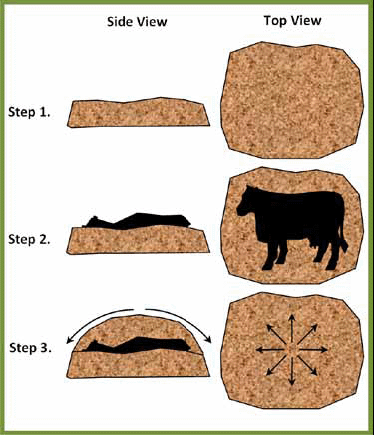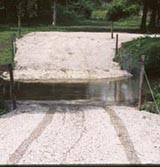Disposing of Animal Mortalities
Composting Large Animal Mortalities
Composting is a planned and managed process to promote the aerobic (with oxygen) degradation of organic matter. This process avoids nuisances created by the anaerobic (without oxygen) degradation of organic matter: malodors and leachate (seeping, noxious liquids).
Static pile composting can be an inexpensive and convenient disposal option for large animal carcasses, particularly if on-farm burial is not feasible and an accommodating Class 1 landfill is not nearby. If large animal mortalities are composted on the same farm where the animal(s) died, permits are not required for the composting piles or for the land application of the finished compost, which will have a modest fertilizer value.
Be aware that the locations where dead animals are managed are considered part of the production area on Concentrated Animal Feeding Operations (CAFOs). If your farm qualifies as a CAFO, consider composting with an under-roof system to avoid leachate generation.
There are three primary requirements to properly compost dead stock in static piles:
- Air (oxygen) must be able to permeate through the pile to the decomposing carcass.
- The carbon-to-nitrogen ratio must about 30:1 (30 parts carbon to 1 part nitrogen).
- The overall moisture content must be 40 to 60 percent.
Large animal carcasses have poor compost characteristics: they have a low C:N ratio (5:1), a high water content and the hide tends to hold moisture in and retard air flow to the bulk of the carcass. Fortunately, simply underlying and covering the carcass with a generous amount of high-carbon, structurally durable and absorbent material will promote composting.
Wood chips absorb odor and retain good “structure” for long periods of time, meaning that durable voids or holes are present that allow air to naturally pass into and filter out of a covered carcass. This is opposed to wet silage or feed, which will prevent air from entering the pile because there are few or no voids present. Be aware that structurally weak amendments like straw tend to disintegrate after they become wet and may then impede air flow.
The mortality compost amendment must be largely carbon to dilute the carcass nitrogen. Woody and herbaceous materials work well because they are largely carbon, while manure and feed, which have low carbon-to-nitrogen ratios, tend not to work as well. In regard to moisture, a good rule of thumb is that the amendment should feel moist, but you shouldn’t be able to readily squeeze water from the material. Acceptable mortality compost amendments are:
- Wood chips (≈ ˝” in diameter) (C:N ≈ 400:1)
- Sawdust (C:N ≈ 325:1)
- Feed refusal (hay and silage) (C:N ≈ 20:1)
- Horse stall waste (C:N ≈ 25:1)
Static pile composting is illustrated in Figure below. First, the carbon amendment should be spread two feet thick in a slightly sloped location (away from property lines). Next, the carcass should be placed squarely on the center of this base material with the extremities at least two feet away from the edge of the base material. Finally, the carcass should be covered with two feet of amendment that is mounded to divert rather than capture rainfall. The process will be complete in 3-9 months (only bones are left) and the material can then be land-applied.

This information is further summarized in The University of Tennessee Extension publication W251, Composting Large Animal Mortalities in Tennessee.
Animal Mortality Quick Reference
- Large Animal Mortalities
- Burying Large Animals
- Composting Large Animals
- Landfilling Large Animals
- Poultry Mortality Incinerators
- Dead Poultry Composting
- Mortality Publications

